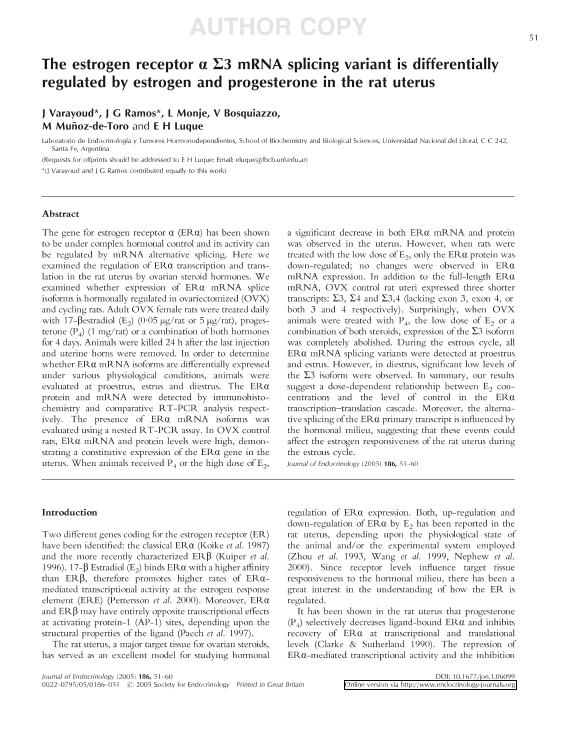Mostrar el registro sencillo del ítem
dc.contributor.author
Varayoud Jorgelina
dc.contributor.author
Ramos J Guillermo
dc.contributor.author
Monje, Lucas Daniel

dc.contributor.author
Bosquiazzo, Veronica Lis

dc.contributor.author
Muñoz de Toro, Monica Milagros

dc.contributor.author
Luque, Enrique Hugo

dc.date.available
2020-04-16T19:58:06Z
dc.date.issued
2005-07
dc.identifier.citation
Varayoud Jorgelina; Ramos J Guillermo; Monje, Lucas Daniel; Bosquiazzo, Veronica Lis; Muñoz de Toro, Monica Milagros; et al.; The estrogen receptor α Σ3 mRNA splicing variant is differentially regulated by estrogen and progesterone in the rat uterus; BioScientifica; Journal of Endocrinology; 186; 7-2005; 51-60
dc.identifier.issn
0022-0795
dc.identifier.uri
http://hdl.handle.net/11336/102798
dc.description.abstract
The gene for estrogen receptor a (ERa) has been shown to be under complex hormonal control and its activity can be regulated by mRNA alternative splicing. Here we examined the regulation of ERa transcription and translation in the rat uterus by ovarian steroid hormones. We examined whether expression of ERa mRNA splic isoforms is hormonally regulated in ovariectomized (OVX) and cycling rats. Adult OVX female rats were treated daily with 17-estradiol (E2) (0·05 μg/rat or 5 μg/rat), progesterone (P4) (1 mg/rat) or a combination of both hormones for 4 days. Animals were killed 24 h after the last injection and uterine horns were removed. In order to determine whether ERa mRNA isoforms are differentially expressed under various physiological conditions, animals were evaluated at proestrus, estrus and diestrus. The ERa protein and mRNA were detected by immunohistochemistry and comparative RT-PCR analysis respectively. The presence of ERa mRNA isoforms was evaluated using a nested RT-PCR assay. In OVX control rats, ERa mRNA and protein levels were high, demonstrating a constitutive expression of the ERa gene in the uterus. When animals received P4 or the high dose of E2,a significant decrease in both ERa mRNA and protein was observed in the uterus. However, when rats were treated with the low dose of E2, only the ERa protein was down-regulated; no changes were observed in ERa mRNA expression. In addition to the full-length ERa mRNA, OVX control rat uteri expressed three shorter transcripts: a3, a4 and a3,4 (lacking exon 3, exon 4, or both 3 and 4 respectively). Surprisingly, when OVX animals were treated with P4, the low dose of E2 or a combination of both steroids, expression of the a3 isoform was completely abolished. During the estrous cycle, all ERa mRNA splicing variants were detected at proestrus and estrus. However, in diestrus, significant low levels of the a3 isoform were observed. In summary, our results suggest a dose-dependent relationship between E2 concentrations and the level of control in the ERa transcription–translation cascade. Moreover, the alternative splicing of the ERa imary transcript is influenced by the hormonal milieu, suggesting that these events could affect the estrogen responsiveness of the rat uterus during the estrous cycle.
dc.format
application/pdf
dc.language.iso
eng
dc.publisher
BioScientifica

dc.rights
info:eu-repo/semantics/openAccess
dc.rights.uri
https://creativecommons.org/licenses/by-nc-sa/2.5/ar/
dc.subject
ESTROGEN RECEPTOR
dc.subject
UTERUS
dc.subject
ESTROGEN
dc.subject
PROGESTERONE
dc.subject
ISOFORMS
dc.subject.classification
Ciencias Veterinarias

dc.subject.classification
Ciencias Veterinarias

dc.subject.classification
CIENCIAS AGRÍCOLAS

dc.title
The estrogen receptor α Σ3 mRNA splicing variant is differentially regulated by estrogen and progesterone in the rat uterus
dc.type
info:eu-repo/semantics/article
dc.type
info:ar-repo/semantics/artículo
dc.type
info:eu-repo/semantics/publishedVersion
dc.date.updated
2020-04-13T13:14:11Z
dc.journal.volume
186
dc.journal.pagination
51-60
dc.journal.pais
Reino Unido

dc.description.fil
Fil: Varayoud Jorgelina. Universidad Nacional del Litoral. Facultad de Bioquímica y Ciencias Biológicas. Departamento de Fisiología. Laboratorio de Endocrinología y Tumores Hormonodependientes; Argentina
dc.description.fil
Fil: Ramos J Guillermo. Universidad Nacional del Litoral. Facultad de Bioquímica y Ciencias Biológicas. Departamento de Fisiología. Laboratorio de Endocrinología y Tumores Hormonodependientes; Argentina
dc.description.fil
Fil: Monje, Lucas Daniel. Universidad Nacional del Litoral. Facultad de Bioquímica y Ciencias Biológicas. Departamento de Fisiología. Laboratorio de Endocrinología y Tumores Hormonodependientes; Argentina
dc.description.fil
Fil: Bosquiazzo, Veronica Lis. Universidad Nacional del Litoral. Facultad de Bioquímica y Ciencias Biológicas. Departamento de Fisiología. Laboratorio de Endocrinología y Tumores Hormonodependientes; Argentina
dc.description.fil
Fil: Muñoz de Toro, Monica Milagros. Universidad Nacional del Litoral. Facultad de Bioquímica y Ciencias Biológicas. Departamento de Fisiología. Laboratorio de Endocrinología y Tumores Hormonodependientes; Argentina
dc.description.fil
Fil: Luque, Enrique Hugo. Universidad Nacional del Litoral. Facultad de Bioquímica y Ciencias Biológicas. Departamento de Fisiología. Laboratorio de Endocrinología y Tumores Hormonodependientes; Argentina
dc.journal.title
Journal of Endocrinology

dc.relation.alternativeid
info:eu-repo/semantics/altIdentifier/doi/http://dx.doi.org/10.1677/joe.1.06099
Archivos asociados
